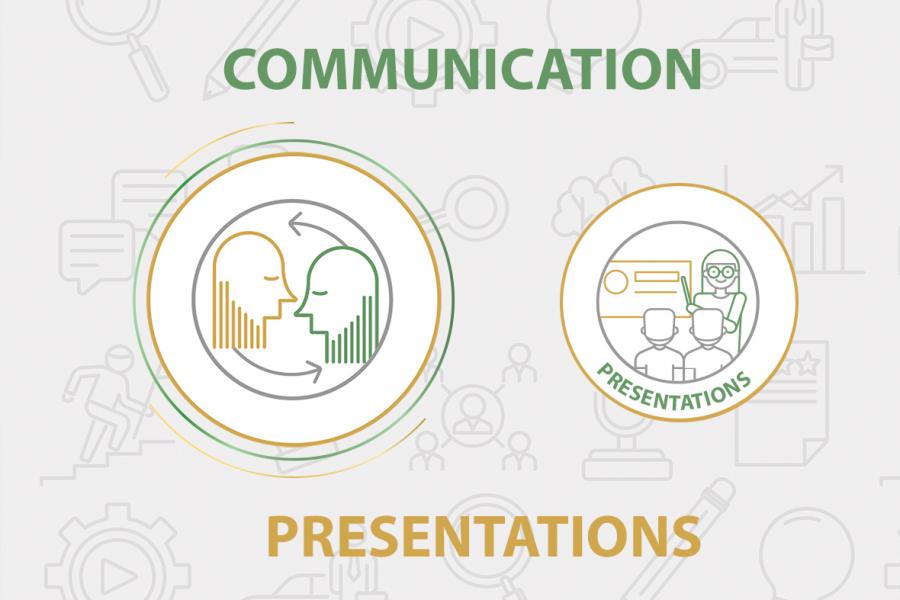 Effective Communication -Presentation Skills
Effective Communication -Presentation Skills
Learning to present information clearly and effectively to communicate your message.
Effective Communication - Presentation Skills
Case Study
"Disastrous" Presentation - Nonku’s Story
Nonkululeko Sibisi has been appointed as Project Manager at the Department of Education and she had to do a presentation at the annual conference on her research findings thus far.
Nonku was passionate about her topic “Challenges faced by teachers in rural schools”, and researched her topic well. She created interesting slides and content to support her presentation. She also structured her presentation with five key points and gave it an introduction, main body and conclusion based on her findings whilst keeping the elements of effective presentations in mind.
Her husband helped her rehearse multiple times beginning a couple of weeks before, until she felt prepared, but she decided to take notes on cue cards to have with her as a reminder tool, just in case she forgot anything.
The day arrived and her husband took the day off from his job to accompany her, knowing that Nonku was still very anxious following a completely sleepless night. Her heart was pounding so hard that her husband said he could actually hear the sound of her beating heart!
Just as Nonku was introduced, she grabbed her cards, began walking up the steps to the stage . . . and suddenly tripped and her cards went flying everywhere. There was some nervous laughter in the audience as the organiser and Nonku gathered her twenty-five cards and to her horror, she realised she had failed to number them.
She took her place at the podium, toughened her nerves and began with, “When giving a presentation make sure to number your cue cards or better yet… rehearse and know your subject matter so cards are unnecessary!”. The audience laughed and a few even applauded.
Thankfully, Nonku had rehearsed enough and thoroughly knew what she was talking about and was able to confidently speak on the slides of the presentation. She gave a really wonderful presentation. Nonku used her incident of dropping the cue cards by explaining that “even experts and seasoned speakers get nervous".
Nonku received a standing ovation and several members told her they thought she had planned the cue card drop as a brilliant and memorable way to begin. Nonku inwardly thanked her husband for listening to her repeatedly as she rehearsed and realised that the way to succeed at presentations is to be really well prepared and believe in what you are talking about. Despite a frightening start, her presentation ended well.
Presentations
- Presenting or making a speech at a conference or event.
- Objecting to a planning proposal at a council meeting.
- Making a speech at a wedding.
- Proposing a vote of thanks to someone at a club or society.
- On behalf of a team, saying goodbye and presenting a gift to a colleague who is leaving.
- Seeking investment or a loan to help you set up a new business.
- Understanding your audience.
- Preparing your content.
- Delivering confidently.
- Controlling the environment.
- Identify five to seven key points and use the chunking principle to organise your information.
- It is not necessary to pack the presentation with loads of information. A good presentation has key points and brief information on every point.
- Use an outline and tell your audience what you intend to cover so they will know what to expect. This helps build anticipation and interest from the start.
- Start and end in a memorable way. In order to get the audiences’ interest, start on a strong note and leave them with a message they will not forget.
- Use real life examples by telling stories and using metaphors to engage your audience fully.
- Practice building confidence. The more we practice the more familiar the content becomes.
- Believe in what you are saying.
- Rehearse until you internalise what you are saying.
- Invite statements from the audience as this builds audience confidence and people are much more likely to trust what you say.
- Use relevant visual aids as this supports your message, but keep it simple and brief.
- Be early and practice in the presentation room, know where the switches, power sockets and exit points are.
- Do your own set-up – make sure the projector has electricity and ensure you have working plugs for your equipment. Batteries can run flat when you do not expect it.
- Test your timing.
A well-presented topic is worth the effort. As practitioners, it is important to have good presentation skills as this serves to inspire and motivate clients to do the same. The more one practices, the more seasoned one becomes and eventually presentations become second nature.
Shared under a Creative Commons Attribution-NonCommercial-NoDerivatives 2.0 South Africa (CC BY-NC-ND 2.0 ZA)
This means you can share and adapt this work but not for commercial purposes. You will only need to include the following reference to the original content in all shared works.
Kindly attribute as follows:
Beukes, C. J., Mahadave, K., & Kanhai, K. (2022). Professional Development Portfolio for Career Development Practitioners (1st ed.). CC BY-NC-SA 2.0 ZA, https://creativecommons.org/licenses/by-nc-nd/2.0/za/
Authors
![]() Sacda
Sacda
![]() Karuna Mahadave
Karuna Mahadave
![]() Christopher John Beukes
Christopher John Beukes

You can earn 1.00 CPD point/s by completing and passing the self-assessment questionnaire for this article.
1.00